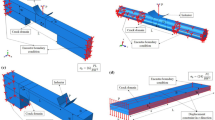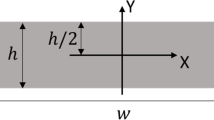Abstract
A novel experimental technique for measuring crack tipT-stress, and hence in-plane crack tip constraint, in elastic materials has been developed. The method exploits optimal positioning of stacked strain gage rosette near a mode I crack tip such that the influence of dominant singular strains is negated in order to determineT-stress accurately. The method is demonstrated for quasi-static and low-velocity impact loading conditions and two values of crack length to plate width ratios (a/W). By coupling this new method with the Dally-Sanford single strain gage method for measuring the mode I stress intensity factorK I , the crack tip biaxiality parameter\(\beta = T\sqrt {{{\pi a} \mathord{\left/ {\vphantom {{\pi a} K}} \right. \kern-\nulldelimiterspace} K}} \) is also measured experimentally. Complementary small strain, static and dynamic finite element simulations are carried out under plane stress conditions. Time histories ofK I andT-stress are computed by regression analysis of the displacement and stress fields, respectively. The experimental results are in good agreement with those obtained from numerical simulations. Preliminary data for critical values ofK I and β for dynamic experiments involving epoxy specimens are reported. Dynamic crack initiation toughness shows an increasing trend as β becomes more negative at higher impact velocities.
Similar content being viewed by others
References
Richardson, D.E. andGoree, J.G., “Experimental Verification of a New Two-parameter Fracture Model,”ASTM-STP, Vol. 1189, American Society for Testing and Materials, Philadelphia, PA, 738–750 (1993).
Chao, Y.J., Liu, S., andBroviak, B.J., “Brittle Fracture: Variation of Fracture Toughness with Constraint and Crack Curving Under Mode I Conditions,” EXPERIMENTAL MECHANICS,41 (3),232–241 (2001).
Irwin, G.R., “Discussion of the Dynamic Stress Distribution Surrounding a Running Crack—A Photoelastic Analysis,”Proceedings of the Society of Experimental Stress Analysis,16, (1),93–96 (1957).
Kirk, M.T., Koppenhoefer, K.C., andShih, C.F., “Effect of Constraint on Specimen Dimensions Needed to Obtain Structurally Relevant Toughness Measures,”Constraint Effects in Fracture, ASTM-STP, Vol. 1171, American Society for Testing and Materials, Philadelphia, PA, 79–103 (1993).
Koppenhoefer, K.C. andDodds, R.H., “Constraint Effects on Fracture Toughness of Impact-loaded, Pre-cracked Charpy Specimens,”Journal of Nuclear Engineering and Design,162 (2–3),145–158 (1996).
Jayadevan, K., Narasimhan, R., Ramamurthy, T., andDattaguru, B., “A Numerical Study in Dynamically Loaded Fracture Specimens,”International Journal of Solids and Structures,38,4987–5005 (2001).
Sanford, R.J., Principles of Fracture Mechanics, Prentice-Hall, Englewood Cliffs, NJ (2002).
Chona, R., Irwin, G.R., andSanford, R.J., “Influence of Specimen Size and Shape on the Singularity-dominated Zone,” Fracture Mechanics 14th Symposium, Vol. 1: Theory and Analysis, ASTM-STP, Vol. 791, American Society for Testing and Materials, Philadelphia, PA, 492–502 (1983).
Tippur, H.V., Krishnaswamy, S., andRosakis, A.J., “Optical Mapping of Crack Tip Deformations Using the Methods of Transmission and Reflection Coherent Gradient Sensing: A Study of Crack Tip K-dominance,”International Journal of Fracture,52,91–117 (1991).
Ramulu, M. andKobayashi, A.S., “Mechanics of Crack Curving and Branching—A Dynamic Fracture Analysis,” EXPERIMENTAL MECHANICS,27,187–201 (1985).
Sumter, J.D.G., “An Experimental Investigation of the T-stress Approach: Constraint Effects in Fracture,“ASTM-STP, Vol. 1171, American Society for Testing and Materials, Philadelphia, PA, 492–502 (1993).
Larsson, S.G. andCarlsson, A.J., “Influence of Non-singular Stress Terms on Small Scale Yielding at Crack Tips in Elastic-plastic Materials,”Journal of the Mechanics and Physics of Solids,21,263–277 (1973).
Rice, J.R., “Limitations to the Small-scale Yielding Approximations for Crack Tip Plasticity,”Journal of the Mechanics and Physics of Solids,22,17–26 (1974).
Kfouri, A.P., “Some Evaluations of the Elastic T-term using Eshelby’s method,”International Journal of Fracture,30,301–315 (1986).
Nakamura, T. andParks, D.M., “Determination of Elastic T-stress along Three-dimensional Crack Fronts Using Interaction Integral,”International Journal of Solids and Structures,29,1597–1611 (1992).
Sladek, J., Sladek, V., andFedelinski, P., “Integral Formulation for Elastodynamic T-stresses,”International Journal of Fracture,84,103–116 (1997).
Yang, B. andRavi-Chandar, K., “Evaluation of Elastic T-stress by Stress Difference Method,”Engineering Fracture Mechanics,64,589–601 (1999).
Dally, J.W. andSanford, R.J., “Strain Gage Methods for Measuring the Opening-mode Stress Intensity Factor, K 1,” EXPERIMENTAL MECHANICS,49,381–388 (1987).
Dally, J.W. andSanford, R.J., “Measuring the Stress Intensity Factor for Propagating Cracks with Strain Gages,”Journal of Testing and Evaluation,18 (4),240–249 (1990).
Westergaard, H.M., “Bearing Pressure and Cracks,” ASME Journal of Applied mechanics,6 (1939).
Williams, M.L., “On the Stress Distribution at the Base of a Stationary Crack,”Journal of the Mechanics and Physics of Solids,24,109–114 (1957).
Rosakis, A.J. andRavi-Chandar, K., “On Crack-tip Stress State: An Experimental Evaluation of Three-dimensional Effects,”International Journal of Solids and Structures,22,121–138 (1986).
Rousseau, C.E. andTippur, H.V., “Dynamic Failure of Compositionally Graded Materials with Cracks Along the Elastic Gradient: Experiments and Analysis,”Mechanics of Materials,33,403–421 (2001).
Anderson, T.L., Fracture Mechanics: Fundamentals and Applications, 2nd edition, CRC Press, New York (1994).
O’Dowd, N.P. andShih, C.F., “Two Parameter Fracture Mechanics: Theory and Applications,”ASTM-STP, Vol. 1207, American Society for Testing and Materials, Philadelphia, PA, 21–47 (1994).
Author information
Authors and Affiliations
Rights and permissions
About this article
Cite this article
Maleski, M.J., Kirugulige, M.S. & Tippur, H.V. A method for measuring mode I crack tip constraint under static and dynamic loading conditions. Experimental Mechanics 44, 522–532 (2004). https://doi.org/10.1007/BF02427964
Received:
Revised:
Issue Date:
DOI: https://doi.org/10.1007/BF02427964




